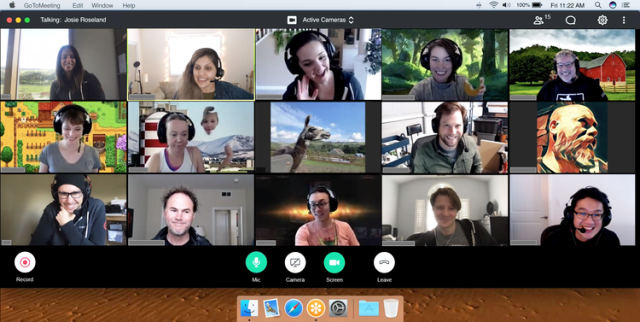
Image source: Sweet Farm
Businesses, nonprofits and other organizations have pivoted from physical to virtual transactions. Business professionals and others have dropped in-person meetings in favor of video conferences via Zoom, GoToMeeting, Webex, and other apps.
A California animal sanctuary’s campaign shows how virtual meetings can produce outsized PR and marketing results. In its Goat-2-Meeting program, Sweet Farm invites virtual visitors to meet its animals in video conferences.
People from around the world have close up meetings with its llamas, cows, sheep and other animals. Video conference participants donate anywhere from $65 to $750 depending on the number of people in the call, length of session and the type of group. Guests usually receive a short tour of the farm, information about the animal, and a chance to ask questions about the sanctuary and the animal.
A New Way to Drive Revenue & Complete its Mission
“After the coronavirus happened and shelter in place went into effect, we had to completely rethink the way we were driving revenue and executing our mission,” Nate Salpeter, Sweet Farm co-founder, told CNN. “Our board member, Jon Azoff, came up with the idea and said, ‘You know, we’re having so many company meetings and happy hours, but they’re all boring. What if we could get a goat or llama on the call’?”
The animals proved excellent brand ambassadors. The Silicon Valley animal sanctuary completed more than 100 calls within a month, and the video conference schedule is already booked for months. Besides generating revenue, the animal’s unscripted performances also raise viewers’ spirits, Salpeter says.
Sweet Water has partnered with other animal sanctuaries, such as Catskill Animal Sanctuary in Saugerties and Woodstock Farm Sanctuary, to meet demand for meeting times.
Media Coverage Drives Results
Lizz DeFeo, marketing and communications manager for Woodstock Farm Sanctuary said on May 13, “We have done barely any publicizing about it and we are booked through the end of May right now. It’s been pretty overwhelming in a positive way.”
Extensive media coverage, including coverage by NPR, Business Insider and other publications, likely drove national and worldwide awareness of the program.
Goat-2-Meeting is a prime example of how a brand with a physical location pivoted to virtual services, said Pamela Bump, marketing manager and blogger, at HubSpot. “Not only is this campaign adorable, but it also allows the farm to generate revenue and spread awareness about its organization’s mission on a viral global scale,” she wrote.
Can Your Brand Pivot to Online Services?
To consider if your brand can make a similar transition, Bump advises considering these questions:
Can any part of your organization’s services be done between a client and a company representative via video chat? Nail salons, tax advisers and health care providers now give consultations online.
If you can’t make your core product virtual, are there other digital resources you can offer online. For instance, Planet Fitness offers online fitness classes.
Does the cost outweigh the reward? Allstate sends drones to review insured sites and confirm damage. L’Oreal developed an augmented reality tool that shows customers how they look in different hairstyles and colors. But hiring an AR developer to create product previews or purchasing a drone to examine job sites, can cost a fortune for a small or medium business.
Bottom Line: An animal sanctuary won widespread media coverage, gained revenue and promoted its mission by arranging video conferences with its animals. Its Goat-2-Meeting program provides a case study of a successful PR and marketing program during the coronavirus epidemic — and a welcome bright spot for nonprofit marketers.
Download the 2020 Ultimate Guide to Media Monitoring, Measurement & Analytics for PR & Marketing

Michael Kling is manager of public relations, marketing and social media at Glean.info, a media monitoring and measurement service that provides customized media monitoring and PR analytics solutions.




